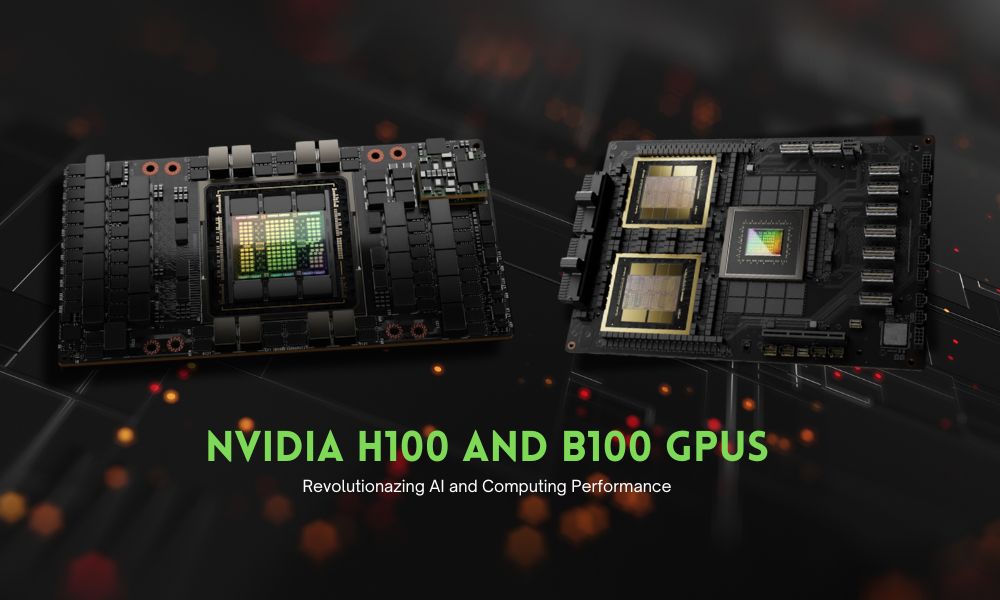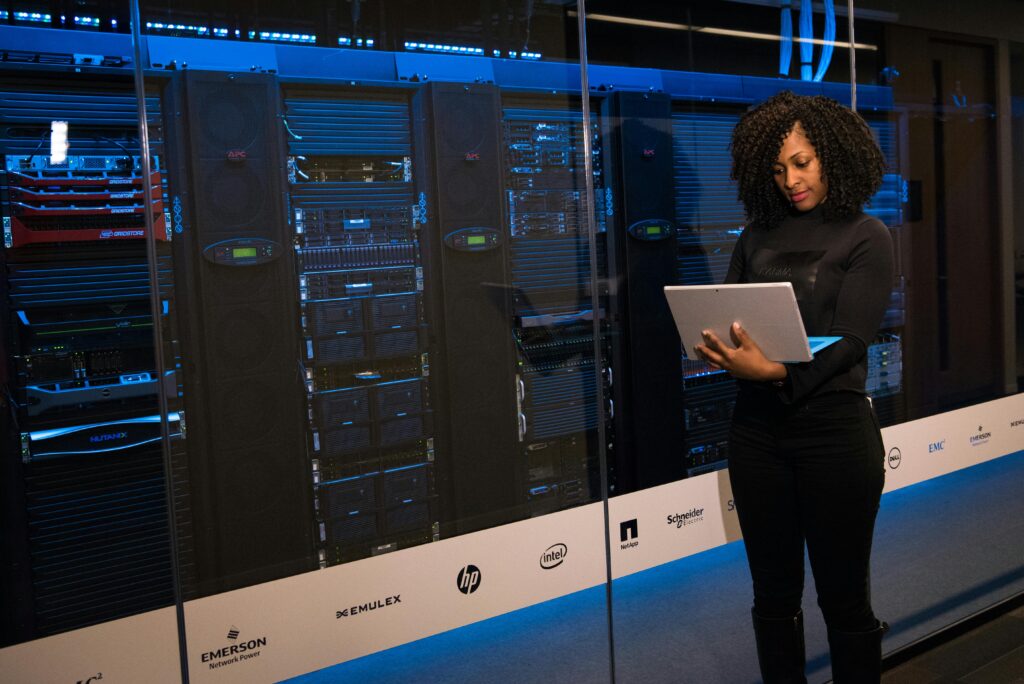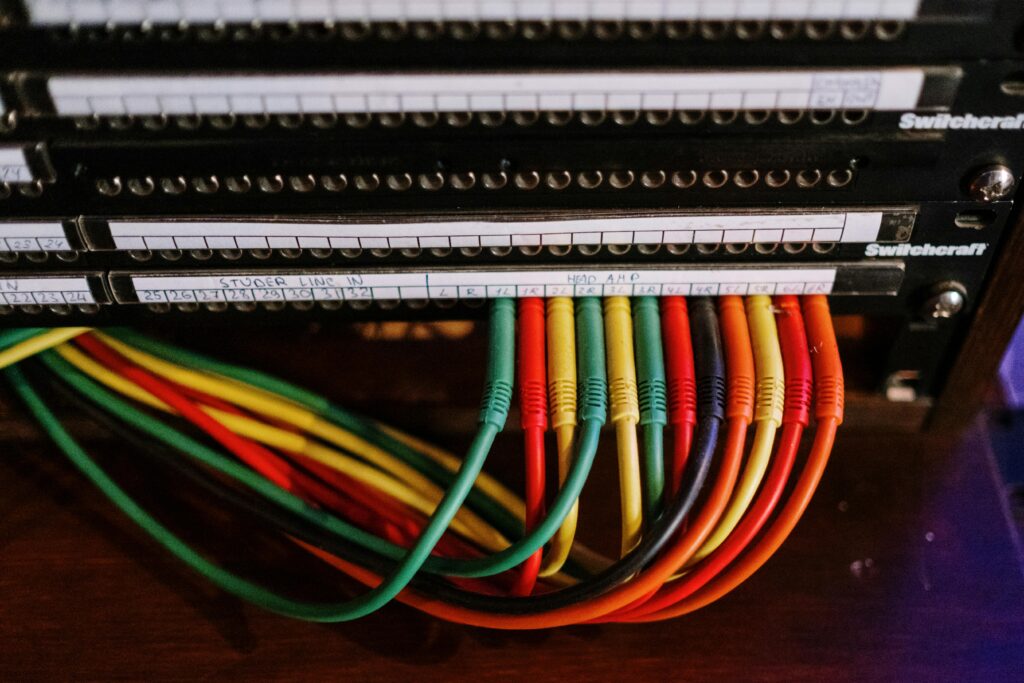In the tech industry, where power and precision are paramount, NVIDIA continues to lead with groundbreaking GPU innovations. Graphic Processing Units (GPUs) have evolved from specialized circuits designed for image rendering to versatile powerhouses capable of handling complex computations. These tasks range from gaming graphics and video processing to advanced scientific research and AI applications, making GPUs indispensable in today’s tech-driven world.
The unveiling of the NVIDIA H100 and B100 GPUs marks a significant leap forward in the realm of high-performance computing, setting new benchmarks in the tech industry. The NVIDIA H100 and B100 represent the zenith of GPU technology, designed to meet the demands of next-generation AI workloads and data-intensive applications. These are built on the innovative Blackwell GPUs architecture, which promises unprecedented efficiency and performance gains.
This blog delves into the intricacies of these GPUs, tracing NVIDIA’s legacy of pioneering advancements, and presenting a detailed comparative analysis of their capabilities.
Technical Specifications
Diving deeper into the NVIDIA H100 and B100, we will explore their technical specifications, which reveal the essence of their superiority. These specifications not only highlight the advancements in GPU technology but also set the stage for a detailed comparison of their architectural and performance nuances.
Architecture
NVIDIA’s Blackwell architecture represents a monumental step forward in GPU design. With the B100, NVIDIA introduces its largest chip yet, featuring a staggering 104 billion transistors. This leap is marked by the transition to dual-chipset designs, a significant enhancement from the previous Hopper architecture. The B100 also boasts 128 billion more transistors than the H100, translating to a remarkable fivefold increase in AI performance. This architectural innovation ensures that the B100 can handle the most demanding computational tasks with unparalleled efficiency and speed.
Memory Configuration
Memory capacity is crucial for handling large datasets and complex computations, and the B100 excels in this area. It is equipped with 192GB of HBM3e memory, more than doubling the 80GB of HBM2e memory found in the H100. This substantial increase allows the B100 to manage more extensive data loads and execute more complex models, making it ideal for advanced AI and machine learning applications. The enhanced memory bandwidth of HBM3e also contributes to faster data access and processing, further boosting the B100’s performance capabilities.
Power Consumption and Efficiency
Power efficiency is a critical factor in GPU performance, especially for data centers aiming to maximize computational power while minimizing energy costs. The B100 excels here as well. Despite its vastly superior performance, the B100 maintains the same 700W power target as the H100.
According to NVIDIA, air-cooled HGX B100 systems can achieve an impressive 14 petaFLOPS of FP4 performance per GPU. This means that data centers currently equipped with DGX H100 systems can seamlessly integrate B100 nodes without needing to upgrade their power infrastructure. The B100’s ability to deliver high performance without additional power requirements underscores its design efficiency and operational cost-effectiveness.
Performance Comparison
To fully appreciate the capabilities of the NVIDIA H100 and B100, we examine their performance across various domains. This comparison not only showcases their strengths but also provides insights into their practical applications in real-world scenarios.
AI and Machine Learning Capabilities
The NVIDIA H100 GPU is designed to handle the most demanding AI and high-performance computing (HPC) tasks. Key features of the H100 include:
- Enhanced Tensor Cores: The H100 features next-generation Tensor Cores, significantly accelerating matrix operations, which are fundamental to AI and machine learning algorithms. These cores boost performance for tasks like image recognition, speech processing, and recommendation systems, making the H100 a powerful tool for AI researchers and developers.
The NVIDIA B100, however, takes AI and machine learning capabilities to new heights. With a substantial increase in processing power and memory, the B100 is widely used in data centers for large-scale AI training and inference. Its key advantages include:
- High Throughput: The B100’s processing speeds surpass anything else available on the market, making it perfect for deep learning models that require high throughput. This is particularly beneficial for applications such as natural language processing, complex simulations, and real-time data analytics.
Graphics and Rendering Performance
The NVIDIA H100 is well-suited for AI and HPC tasks, but it is also a viable option for gaming and rendering, particularly for those focused on training large language models. Its capabilities in accelerating matrix operations and handling complex computations make it a cost-effective choice for these applications.
On the other hand, the B100 is specifically optimized for the AI and HPC segment. Its design does not prioritize gaming and rendering, as the consumer-focused “GB200” series will address these needs. NVIDIA’s upcoming RTX 50-series is expected to cater to the gaming market, providing specialized performance for gaming and rendering tasks.
Data Center and Cloud Performance
Deploying H100 GPUs at data center scale delivers outstanding performance, bringing the next generation of exascale high-performance computing (HPC) and trillion-parameter AI within reach of researchers. The H100 excels in data centers by:
- Scalability: H100 GPUs can be deployed at scale, offering inference performance for large-scale computations and AI workloads.
- Efficiency: With enhanced tensor cores and robust architecture, the H100 provides efficient processing power for data centers.
The NVIDIA Blackwell GPU B100 offers significant improvements for data centers, enhancing their computing capabilities with:
- Increased Processing Power: The B100 features more CUDA and tensor cores, enabling higher parallel processing power. This results in faster information processing and reduced time required for training complex AI models.
- Improved NVLink Technology: Enhanced NVLink technology ensures quick inter-GPU communication across multiple devices, reducing latency and enabling efficient multi-GPU setups. This is crucial for large-scale AI training and inference tasks that require seamless communication between GPUs.
Use Cases and Applications
Explore the diverse applications of the NVIDIA H100 and B100 GPUs across various industries. From powering AI-driven technologies to enhancing graphics in gaming and professional visualization, let’s examine how each GPU fits into specific use cases, providing insights into their practical implementations and industry impact.
Scientific Research
The H100 and B100 both excel in computational simulations and data analysis, but the B100’s enhanced architecture offers significantly higher performance. Researchers modeling complex systems like weather patterns, astrophysics, chemical reactions, and biological processes will benefit more from the B100’s ability to handle larger datasets with greater speed. The B100’s superior processing capabilities accelerate discoveries in fields like genomics and particle physics, making it a preferred choice for cutting-edge scientific research.
Enterprise Applications
The H100 and B100 GPUs are perfect for enterprises dealing with big data processing and financial modeling. Their ability to process and analyze large volumes of data quickly makes them ideal for industries such as retail, telecommunications, and logistics, where insights from big data drive decision-making and strategy. Financial institutions benefit from these GPUs in modeling complex financial scenarios, risk assessment, and algorithmic trading, enabling real-time data analysis and predictive modeling essential for staying competitive in the financial sector.
Healthcare and Biotechnology
In healthcare, the H100 and B100 GPUs enhance medical imaging technologies by providing high-resolution image processing and analysis. Applications such as MRI, CT scans, and X-rays benefit from the GPUs’ ability to quickly process large image datasets, aiding in accurate diagnosis and treatment planning.
In genomics, the B100’s superior processing power accelerates the sequencing and analysis of genetic data, crucial for personalized medicine, where understanding an individual’s genetic makeup can lead to more effective treatments and interventions, significantly advancing healthcare outcomes.
Cost Analysis
When considering the adoption of NVIDIA’s H100 and B100 GPUs, understanding the cost implications is important. This includes not only the initial purchase price but also the total cost of ownership, which encompasses maintenance, upgrades, energy, and cooling costs.
H100: The H100 is NVIDIA’s current top-of-the-line data center GPU, priced roughly between $25,000 and $30,000 per unit. This makes it a substantial investment for organizations looking to enhance their computational capabilities. Despite its high cost, the H100 offers significant performance improvements and is well-suited for a wide range of applications, from AI and machine learning to big data processing and scientific research.
B100: NVIDIA’s B100 GPU, positioned as an entry-level model in the Blackwell series, has an average selling price (ASP) between $30,000 and $35,000. While it is slightly more expensive than the H100, the B100 offers enhanced processing power, memory capacity, and efficiency. This makes the B100 a compelling option for organizations that require the highest levels of performance for AI training, large-scale data analysis, and other demanding computational tasks.
Total Cost of Ownership
Both the H100 and B100 require regular maintenance to ensure optimal performance. Given their advanced architecture, firmware updates, and potential hardware upgrades are part of maintaining these GPUs. The cost of upgrades may be higher for the B100 due to its more complex architecture and additional features. Organizations must consider these ongoing expenses when evaluating the total cost of ownership.
Energy consumption and cooling requirements can also significantly impact the total cost of ownership for high-performance GPUs. The H100 and B100 have similar power targets, with the B100 maintaining the same 700W power target as the H100. However, the B100’s advanced processing capabilities may result in higher overall energy usage during peak performance periods. Effective cooling solutions are essential to prevent overheating and ensure consistent performance. Data centers must invest in efficient cooling systems to manage the heat output of these powerful GPUs, adding to the operational costs.
Future Prospects
As we look ahead, the future prospects for NVIDIA’s GPUs are promising, marked by upcoming technological advances and evolving market trends. NVIDIA’s roadmap for future GPUs indicates a continued focus on enhancing performance and efficiency, with the Blackwell GPU architecture paving the way for significant upgrades and innovations. The anticipated release of the B200 and other forthcoming models promises further improvements in processing power, memory capacity, and energy efficiency. These advancements are expected to meet the increasing demands of AI, machine learning, and high-performance computing, providing even greater computational capabilities and supporting more complex and data-intensive applications.
In terms of market trends, the demand for high-performance GPUs is forecasted to grow substantially. This growth is driven by the expanding applications of AI across various industries, from healthcare and biotechnology to finance and entertainment. As organizations increasingly rely on advanced computational tools to gain competitive advantages, the need for powerful GPUs like the H100 and B100 will continue to rise. The competitive landscape is also evolving, with other technology companies striving to develop their own high-performance GPUs to rival NVIDIA’s offerings.
Embracing the Future of High-Performance Computing
The NVIDIA H100 and B100 GPUs represent the pinnacle of GPU technology, each offering unique strengths across various applications. From scientific research and gaming to enterprise solutions and healthcare, these GPUs are designed to meet the most demanding computational needs. As NVIDIA continues to innovate with upcoming models like the The NVIDIA GB200 Grace Blackwell Superchip, the future of high-performance computing looks brighter than ever. Investing in these powerful GPUs can transform your operations, driving efficiency, performance, and innovation.





